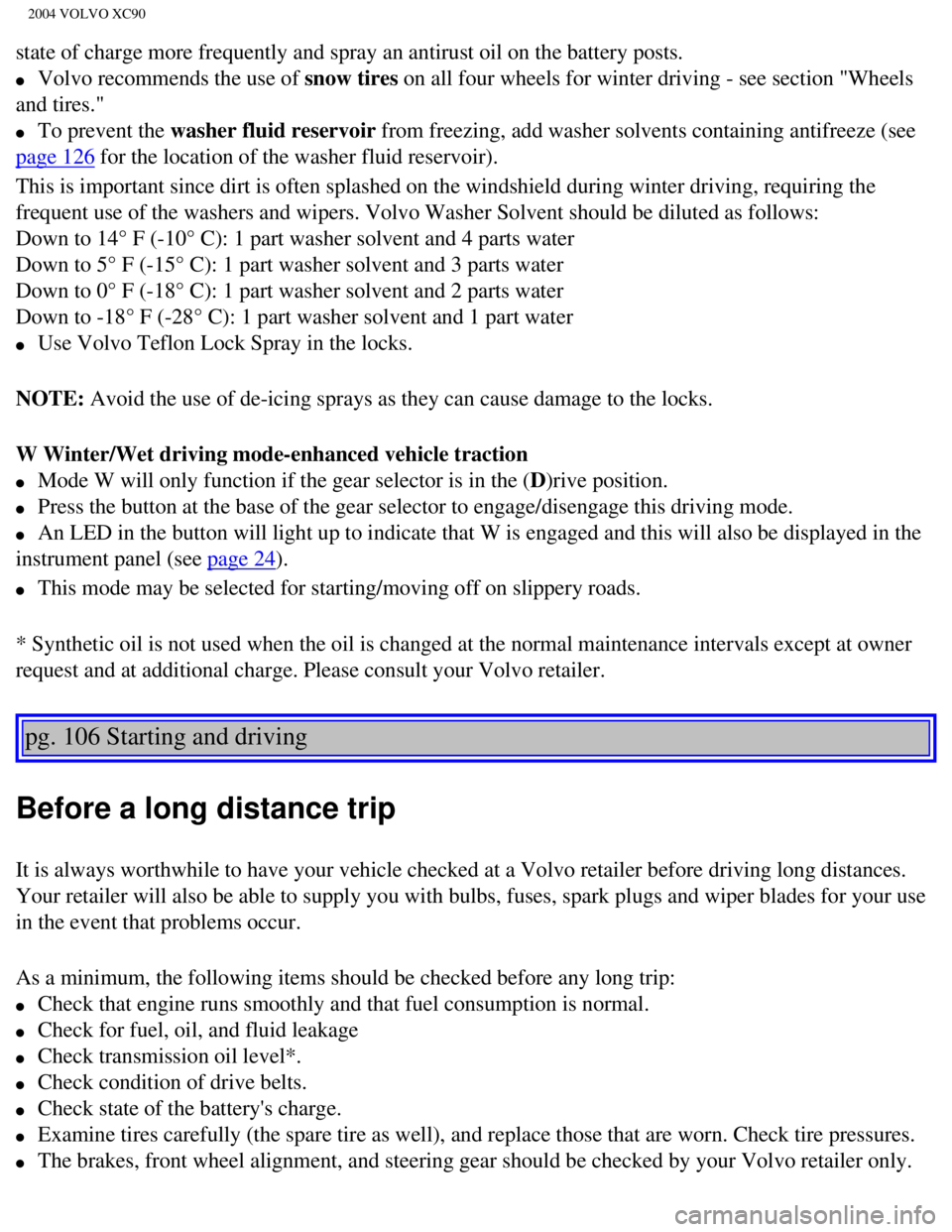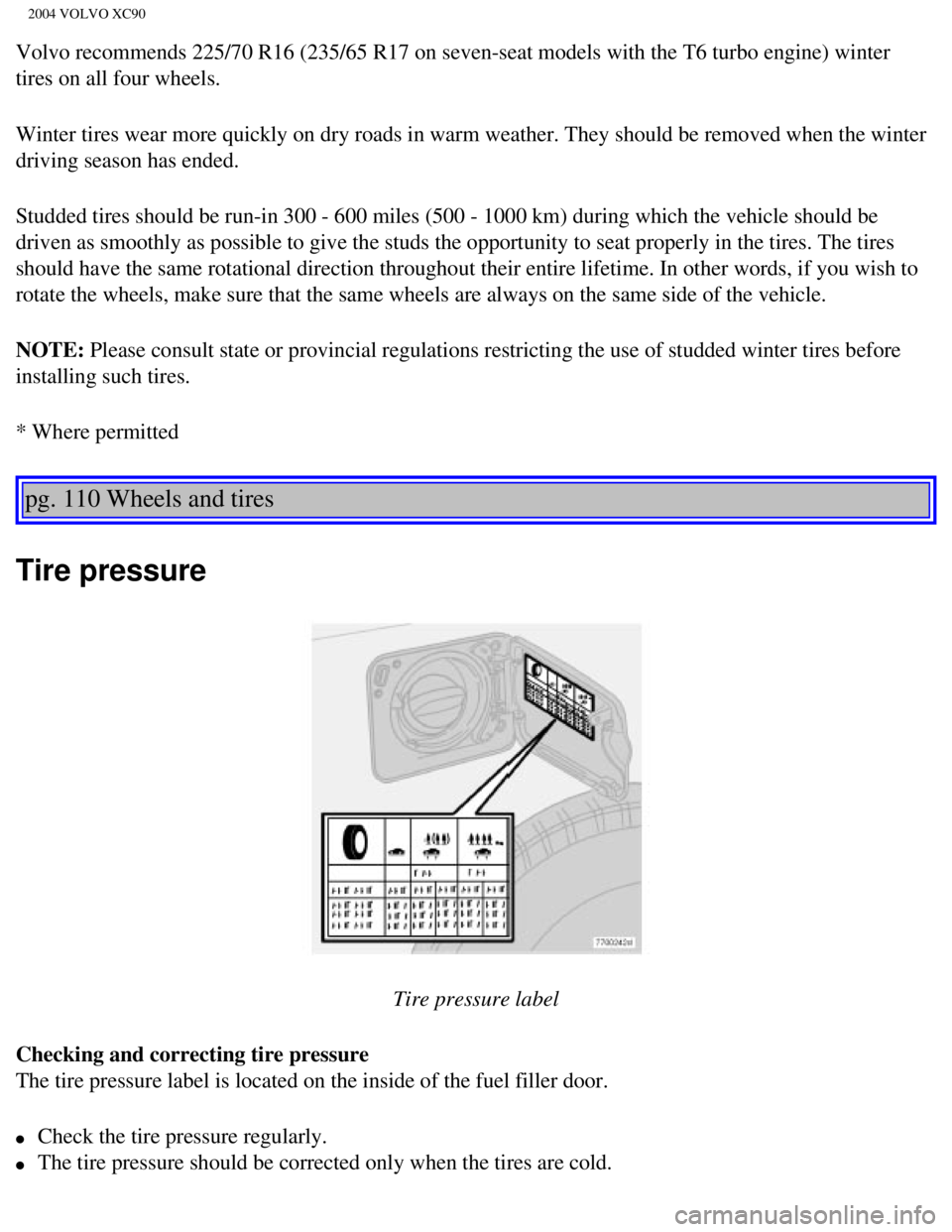2004 VOLVO XC90 four wheel drive
[x] Cancel search: four wheel drivePage 137 of 245

2004 VOLVO XC90
state of charge more frequently and spray an antirust oil on the battery\
posts.
l Volvo recommends the use of snow tires on all four wheels for winter driving - see section "Wheels
and tires."
l To prevent the washer fluid reservoir from freezing, add washer solvents containing antifreeze (see
page 126 for the location of the washer fluid reservoir).
This is important since dirt is often splashed on the windshield during \
winter driving, requiring the
frequent use of the washers and wipers. Volvo Washer Solvent should be d\
iluted as follows:
Down to 14° F (-10° C): 1 part washer solvent and 4 parts water \
Down to 5° F (-15° C): 1 part washer solvent and 3 parts water
Down to 0° F (-18° C): 1 part washer solvent and 2 parts water
Down to -18° F (-28° C): 1 part washer solvent and 1 part water \
l Use Volvo Teflon Lock Spray in the locks.
NOTE: Avoid the use of de-icing sprays as they can cause damage to the locks.
W Winter/Wet driving mode-enhanced vehicle traction
l Mode W will only function if the gear selector is in the (D)rive position.
l Press the button at the base of the gear selector to engage/disengage th\
is driving mode.
l An LED in the button will light up to indicate that W is engaged and thi\
s will also be displayed in the
instrument panel (see
page 24).
l This mode may be selected for starting/moving off on slippery roads.
* Synthetic oil is not used when the oil is changed at the normal mainte\
nance intervals except at owner
request and at additional charge. Please consult your Volvo retailer.
pg. 106 Starting and driving
Before a long distance trip
It is always worthwhile to have your vehicle checked at a Volvo retailer\
before driving long distances.
Your retailer will also be able to supply you with bulbs, fuses, spark p\
lugs and wiper blades for your use
in the event that problems occur.
As a minimum, the following items should be checked before any long trip\
:
l Check that engine runs smoothly and that fuel consumption is normal.
l Check for fuel, oil, and fluid leakage
l Check transmission oil level*.
l Check condition of drive belts.
l Check state of the battery's charge.
l Examine tires carefully (the spare tire as well), and replace those th\
at are worn. Check tire pressures.
l The brakes, front wheel alignment, and steering gear should be checked b\
y your Volvo retailer only.
file:///K|/ownersdocs/2004/2004_XC90/04xc90_06b.htm (16 of 17)12/30/20\
06 4:35:23 PM
Page 145 of 245

2004 VOLVO XC90
road holding on slippery surfaces than tires without the "all-season" ra\
ting.
However, for optimum road holding on icy or snow-covered roads, we recom\
mend suitable winter tires
on all four wheels. When replacing tires, be sure that the new tires are\
the same size designation, type
(radial) and preferably from the same manufacturer, on all four wheels\
. Otherwise there is a risk of
altering the vehicle's roadholding and handling characteristics.
NOTE: When storing wheel/tire assemblies (e.g. winter tires and wheels), eit\
her stand the assemblies
upright, or suspend them off the ground. Laying wheel/tire assemblies on\
their sides for prolonged
periods can cause wheel and/or tire damage.
New tires
Remember that tires are perishable goods. As of 2000, manufacturing year\
and week will be indicated
with 4 digits (e.g. 1502 means that the tire is manufactured year 2002,\
week 15).
Improving tire economy:
l Maintain correct tire pressure. See the tire pressure label on the insid\
e of the fuel filler door.
l Drive smoothly: avoid fast starts, hard braking and tire screeching.
l Tire wear increases with speed.
l Correct front wheel alignment is very important.
l Unbalanced wheels impair tire economy and driving comfort.
l If tires are rotated, they must be kept on the same side of the vehicle \
so that they revolve in the same
direction as before rotation.
l Hitting curbs or potholes can damage the tires and/or wheels permanently\
.
Flat spots
All tires become warm during use. After cooling, when the vehicle is par\
ked, the tires have a tendency to
distort slightly, forming flat spots. These flat spots can cause vibrati\
ons similar to the vibrations caused
by unbalanced wheels. They do, however, disappear when the tire warms up\
. The degree to which flat
spots form depends on the type of cord used in the tire. In cold weather\
, it takes longer for the tire to
warm up and consequently longer for the flat spot to disappear.
file:///K|/ownersdocs/2004/2004_XC90/04xc90_08.htm (2 of 13)12/30/2006\
4:35:25 PM
Page 146 of 245

2004 VOLVO XC90
CAUTION
The vehicle must not be driven with wheels of different dimensions or wi\
th a spare tire other than the
one that came with the vehicle. The use of different size wheels can ser\
iously damage your vehicle's
transmission.
pg. 109 Wheels and tires
Snow chains
Snow chains can be used on your Volvo with the following restrictions:
l Snow chains should be installed on front wheels only. Use only Volvo app\
roved snow chains.
l If accessory, aftermarket or "custom" tires and wheels are installed and\
are of a size different than the
original tires and wheels, chains in some cases CANNOT be used. Sufficie\
nt clearances between chains
and brakes, suspension and body components must be maintained.
l Some strap-on type chains will interfere with brake components and there\
fore CANNOT be used.
l All Wheel Drive models: Snow chains should only be installed on the front wheels. Only chains
adapted for AWD models should be used.
NOTE: Consult your Volvo retailer for additional snow chain information.
CAUTION
- Check local regulations regarding the use of snow chains before instal\
ling. Always follow the chain
manufacturer's installation instructions carefully. Install chains as ti\
ghtly as possible and retighten
periodically.
- Never exceed the chain manufacturer's specified maximum speed limit. (\
Under no circumstances
should you exceed 31 mph 50 km/h)
- Avoid bumps, holes or sharp turns when driving with snow chains.
- The handling of the vehicle can be adversely affected when driving wit\
h chains. Avoid fast or sharp
turns as well as locked wheel braking.
Snow tires, studded tires*
Tires for winter use:
Owners who live in or regularly commute through areas with sustained per\
iods of snow or icy driving
conditions are strongly advised to fit suitable winter tires to help ret\
ain the highest degree of traction.
It is important to install winter tires on all four wheels to help retai\
n traction during cornering, braking,
and accelerating. Failure to do so could reduce traction to an unsafe le\
vel or adversely affect handling.
Do not mix tires of different design as this could also negatively affec\
t overall tire road grip.
file:///K|/ownersdocs/2004/2004_XC90/04xc90_08.htm (3 of 13)12/30/2006\
4:35:25 PM
Page 147 of 245

2004 VOLVO XC90
Volvo recommends 225/70 R16 (235/65 R17 on seven-seat models with the T\
6 turbo engine) winter
tires on all four wheels.
Winter tires wear more quickly on dry roads in warm weather. They should\
be removed when the winter
driving season has ended.
Studded tires should be run-in 300 - 600 miles (500 - 1000 km) during \
which the vehicle should be
driven as smoothly as possible to give the studs the opportunity to seat\
properly in the tires. The tires
should have the same rotational direction throughout their entire lifeti\
me. In other words, if you wish to
rotate the wheels, make sure that the same wheels are always on the same\
side of the vehicle.
NOTE: Please consult state or provincial regulations restricting the use of st\
udded winter tires before
installing such tires.
* Where permitted
pg. 110 Wheels and tires
Tire pressure
Tire pressure label
Checking and correcting tire pressure
The tire pressure label is located on the inside of the fuel filler door\
.
l Check the tire pressure regularly.
l The tire pressure should be corrected only when the tires are cold.
file:///K|/ownersdocs/2004/2004_XC90/04xc90_08.htm (4 of 13)12/30/2006\
4:35:25 PM